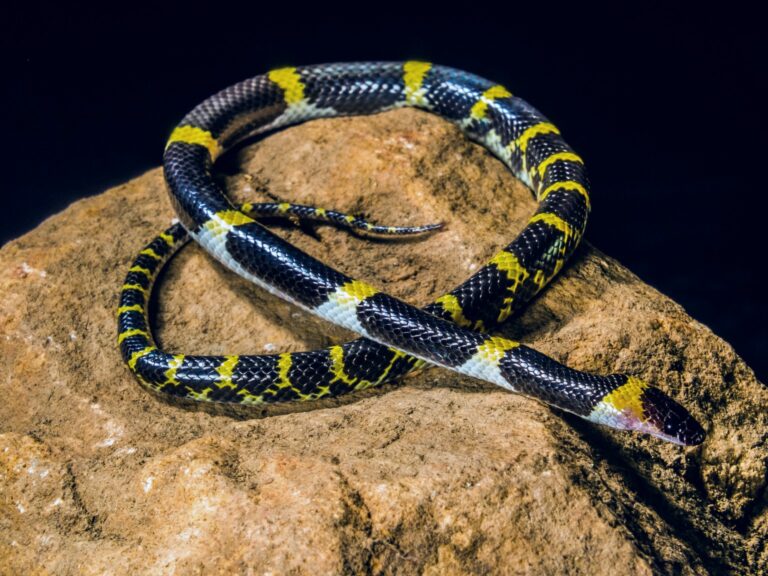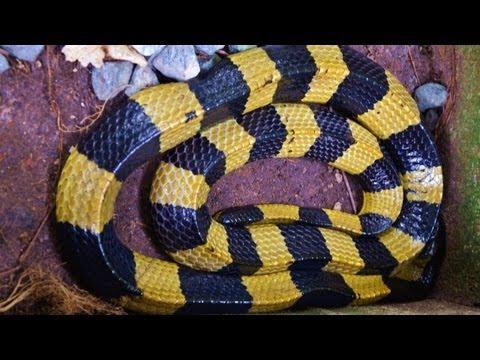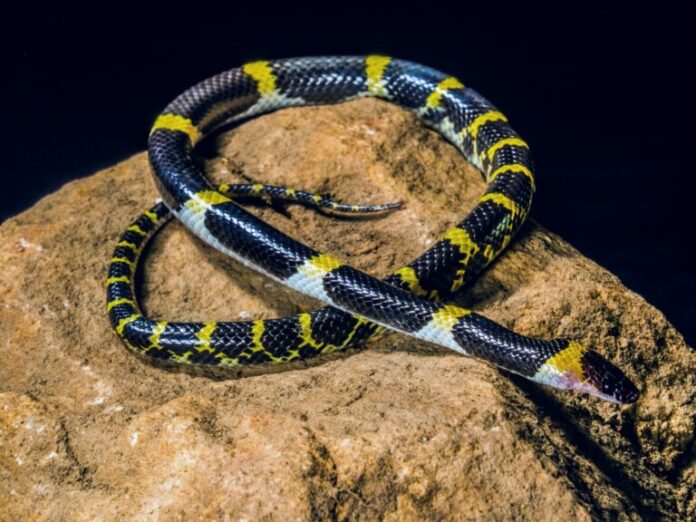There are all kinds of snake species in North America, and countless more around the globe.

In fact, there is so much variety when it comes to snakes (species, subspecies, and even regional variations, and color morphs) that it makes positively identifying any given snake using color alone quite challenging most of the time…
Assuming that I snake is not dangerous based on color alone could prove to be a fatal mistake, and you’ll need more information about a given species to positively identified.
But how about something vividly colored like black and yellow snakes? Are black and yellow snakes venomous, and dangerous?
They can be. Some black and yellow snakes are non-venomous, and pose no risk to people. Others, such as certain sea snakes, are venomous and highly dangerous.
Once again, we cannot rely upon conventional wisdom, catchy rhymes or anything else to help us determine if a brightly colored black and yellow snake is it venomous and dangerous or totally harmless.
The only thing you can rely on is expert knowledge of the physiology of a given species…
But in all cases, if you are not an expert and trained accordingly never approach any snake that you cannot truly identify.
Keep reading, and I will tell you more about the black and yellow snake conundrum below.

What Do Black and Yellow Snakes Look Like?
Like I mentioned above, there’s a tremendous amount of variety across the hundreds and hundreds of snake species found across the globe. Color, pattern, build, size, and more.
But even looking at some more or less “standard” color patterns, such as black and yellow for instance, we see plenty of variation still.
Some are glossy and bright with high-contrast scales, others might be dull and muted. Some snakes might have yellow stripes, others might have yellow bands.
The black scales of some of these snakes might be a glossy, alluring color while others might have a dusty gray look.
Even then, we must look at the distribution of the color pattern. Does this pattern run from nose to tail? Is the belly of the snake counter-shaded? How big is the snake? Are they stocky, are they slender? How big are the eyes, what do the pupils look like?
There’s simply too much variation to positively determine, most of the time, if any given black and yellow snake is dangerous or not if you’re going by color alone.
Where are Black and Yellow Snakes Found?
Unfortunately, the region where you live is probably not going to help you further determine whether any given black and yellow snake is dangerous.
By color alone, black and yellow snakes are located across the globe, in most regions, on land and in the oceans.
You will still need more information to positively ID the snake.
Are Black and Yellow Snakes Venomous?
Some are, most aren’t. Again, it depends on the species. And don’t bank on the fact that most black and yellow snakes are non-venomous; black and yellow snakes that are venomous typically pack lethally dangerous venom, like the yellow-bellied sea snake I mentioned above.
If you are wrong, it could cost you a limb or even your life.
A bite from a venomous snake could leave you paralyzed, delirious, and unable to breathe or else bleeding out internally depending on the type of venom that was injected.
If another, non-venomous black and yellow snake were to bite you, you might have some small cuts and nothing more. Do you really care to gamble on that?
Can Black and Yellow Snakes Kill Pets or Domestic Animals?
They can, of course, and once again depending upon the species of snake.
Most non-venomous black and yellow snakes will simply prove to be a menace to farmers and homesteaders that have chickens or ducks, because these snakes disproportionately eat bird eggs, chicks, ducklings, and other small creatures they’re able to kill.
Of course, larger pets and other domestic animals like cows, goats, chickens, sheep, dogs, and so forth won’t be unduly threatened by these slithering reptiles, but might still be startled enough by their appearance to injure themselves or other animals.
On the other hand, venomous black and yellow snakes can easily kill animals far larger than themselves, including cows and horses, and most worryingly people.
Accidentally stepping on or coming near a concealed venomous snake is enough to provoke a bite with fatal consequences.
Will Black and Yellow Snakes Attack Humans?
They certainly might, again depending on the temperament of the specific species we are talking about.
Now, talking in broad generalizations, the vast majority of snakes on earth, including black and yellow species, are not overtly aggressive towards human beings, or any large animal for that matter.
Most snakes desperately want to avoid being stepped on, and also want to avoid drawing attention to themselves.
To do this, snakes will, as a rule, retreat from the approach of something much larger than themselves.
But, we can run into trouble when dealing with a species that prefers to lie still or play dead when threatened.
We might inadvertently draw closer to the snake until it thinks it has no choice to defend itself except through a bite.
And then, not for nothing, certain snake species are aggressive, vigorously defending themselves and their immediate territory by going on the offensive to drive off threats.
But in all cases, snakes are wild animals, and being wild animals they are unpredictable and you should never take it for granted that any species of yellow and black snake won’t become aggressive at your approach.

Will a Black and Yellow Snake Bite Hurt You?
Just assume that it will… Again, depending on the species, a bite could inflict minor lacerations, serious cuts or potentially deadly envenomation.
No snake bite will feel good, I can promise you that. If a small rat snake bites you, you’ll definitely know what happened, but that’s it.
If a venomous sea snake bites you, your remaining moments before you drown will be transcendent agony.
Is it Best to Kill Black and Yellow Snakes When You Can?
No, if possible and safe to do so. All snakes, even the scary venomous ones, have an important part to play in nature and in their local ecosystems.
Sadly, many snakes are summarily dispatched out of fear or paranoia, when a little bit of knowledge goes a long way towards preserving the lives and limbs of people and also of the snakes.
All you need to do to avoid a negative interaction with snakes is to stay away from them.
However, if your life, the lives of other people, or the lives of your animals might be in danger you might not have any choice in the matter.
If it’s possible, try to have a snake captured and relocated, but if it’s not possible, kill it.


